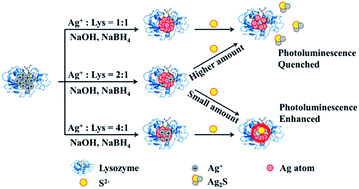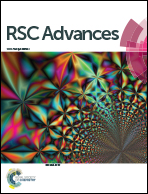Lysozyme-stabilized Ag nanoclusters: synthesis of different compositions and fluorescent responses to sulfide ions with distinct modes†
Abstract
In this study, three red-emissive Ag nanoclusters capped with denatured lysozyme (dLys-AgNCs 1–3) were synthesized from different reactant molar ratios of AgNO3 and lysozyme. dLys-AgNCs 1 contained only Ag(0), whereas dLys-AgNCs 2 and 3 contained both Ag(0) and Ag(I). The maximum emission wavelengths of dLys-AgNCs 1–3 were all near 640 nm when excited at 490 nm, but had different photoluminescence intensities. The photoluminescence properties of the dLys-AgNCs in the presence of common inorganic anions were studied. dLys-AgNCs 1–3 had a distinct photoluminescence response to S2−. The photoluminescence of dLys-AgNCs 1 was quenched by S2−, because S2− destroyed the nanostructure of dLys-AgNCs 1 by forming Ag2S. The photoluminescence of dLys-AgNCs 3 was enhanced by S2−, because S2− bound to Ag(I) in dLys-AgNCs 3 and altered the ligand-to-metal–metal charge transfer. For dLys-AgNCs 2, the photoluminescence was enhanced with a small amount of S2− and quenched when more S2− was added. This was explained by S2− binding to Ag(I) at low concentrations and then to Ag(0) at high concentrations. Other anions had no obvious effects, except that I− quenched the photoluminescence of dLys-AgNCs 1–3. The response mechanisms were investigated by XPS, MS, zeta potential, DLS, and fluorescence lifetime measurements. As-prepared dLys-AgNCs 1 and 3 were used as fluorescent probes for S2− detection in tap water and lake water with satisfactory results.


 Please wait while we load your content...
Please wait while we load your content...